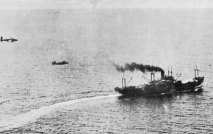 |
The decision to leave Guadalcanal was, for the Japanese, a difficult one to make. As we have seen, the Japanese military realized it couldn’t hold the island because it couldn’t re-supply the island. Still, the warrior mentality of “no retreat” was tough to overcome. Fortunately, their “out” came in the cause of reinforcing New Guinea. So troops were removed from Guadalcanal, and those waiting to go to Guadalcanal were redirected.
More than 6,000 soldiers of the Japanese 51st Division were packed into six transports, which set out from Rabaul on the evening of February 28, 1943. Rabaul sits on the northeast corner of New Britain Island and was one of Japan’s strongest Pacific fortresses. But once in open waters, the transports would be exposed to enemy aircraft based at Port Moresby (which the Japanese had failed to capture the year before), Papua, and other bases. So the convoy was protected by a crack team of eight destroyers and a bevy of fighter aircraft. The convoy passed through the Bismarck Sea, with the goal of rounding New Britain’s western tip, turning south, and landing at Lae (here’s a map of the movements).
The convoy was spotted by U.S. scout planes on March 1st, but cloud cover protected the convoy until the 2nd, when the Battle of the Bismarck Sea got under way. B-17’s hit the convoy first, fatally hitting one of the transports. It stayed afloat just long enough to offload 8-900 surviving soldiers onto two of the destroyers, which sped ahead and dropped them off at Lae. They would be the only soldiers to reach their destination.
March 3, 1943 saw most of the action as the convoy turned south into the Vitiaz Strait, less than 100 miles from their goal. It was then that the Americans and Australians struck…and struck hard. WWII-era bombers were generally not that accurate (particularly against ships), but this was a remarkable exception, as 75% of the bombs from the first wave of bombers hit home. A fuel ship was obliterated by a direct hit. The transports were hit one after the other, as were the defending destroyers. When the Japanese Zero’s swept in, they were met by P-38 Lightnings, P-40 Warhawks (of Flying Tigers fame), and P-39 Airacobras.
By mid-afternoon, the majority of the fighting was over. Seven of the eight transports were gone (the eighth was dead in the water and would be sunk that night). Two destroyers were sunk and two more were also dead in the water (to be sunk the next day in the Battle’s final action), and at least half the Japanese aircraft had been shot down. More than half of the 6,000 soldiers headed for Lae were killed, and any survivors were scooped up and taken back to Rabaul. U.S. losses amounted to 2 bombers and 3 fighters.
The Japanese lost Guadalcanal because they couldn’t keep their troops supplied. The Battle of the Bismarck Sea prevented a large reinforcement of New Guinea. Seven months later, the Japanese would lose New Guinea. Coincidence?
Recommended Reading: Fire in the Sky: The Air War in the South Pacific – A more technical look at the South Pacific than what you’re probably used to, but still valuable.